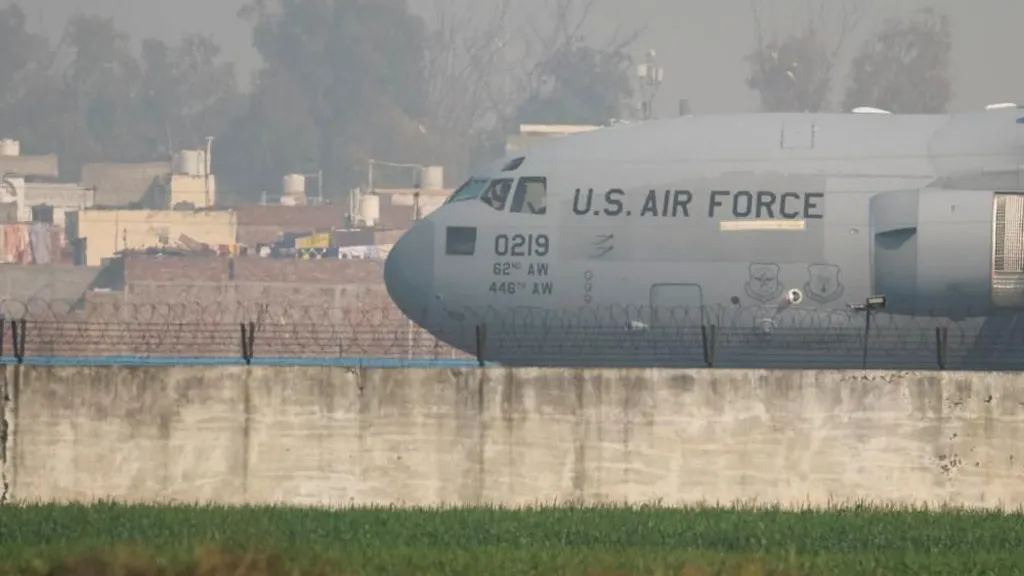India and the United States are now at the center of a global controversy after reports surfaced that Indian deportees were shackled throughout a grueling 40-hour military flight back to their home country. This incident has triggered outrage from human rights organizations, opposition leaders, and international observers who see it as a gross violation of human dignity. The deportation flight, which carried 104 Indian nationals accused of entering the US illegally, landed in Amritsar, India, on Wednesday. While the US maintains that its immigration enforcement policies are critical to national security and public safety, the treatment of deportees has raised serious ethical and diplomatic concerns.
One of the deportees, Jaspal Singh, shared his traumatic experience with BBC Punjabi, describing how his hands and feet were bound for the entire journey, with only brief moments of relief when he needed to use the restroom. Singh’s account has fueled criticism of US deportation practices, with many questioning the necessity of treating individuals like dangerous criminals. Singh revealed that he had paid a staggering 4 million rupees ($46,000) to secure an illegal route into the US, a journey that took months and exposed him to extreme dangers, including witnessing the bodies of fellow migrants who did not survive the treacherous path. Despite the high risks and financial burden, many continue to pursue illegal entry into the United States, driven by a lack of opportunities in their home countries and the hope of a better future.
India’s Foreign Minister S. Jaishankar, addressing the Indian Parliament, stated that the government is actively engaging with US authorities to ensure that Indian citizens are not mistreated while being deported. He confirmed that, according to US Immigration and Customs Enforcement (ICE), women and children were not restrained during the flight and that deportees had access to food and medical attention when needed. However, this official explanation has done little to calm public outrage, as testimonies from deportees contradict these claims. Many Indians feel that their government should take a stronger stance against what they see as an insult to their national dignity. Opposition leaders have called the situation “shocking and shameful,” with Congress MP Shashi Tharoor emphasizing that while the US has the right to deport individuals who entered illegally, the manner in which they were sent back—handcuffed and transported on a military aircraft—was deeply disrespectful.
The controversy has placed the Indian government in a diplomatic bind, as it seeks to balance maintaining strong ties with Washington while also addressing domestic anger. President Donald Trump, who has made mass deportations a key pillar of his administration’s immigration policy, has emphasized that India must accept the return of its undocumented nationals. Trump has publicly stated that Indian Prime Minister Narendra Modi assured him that India would cooperate with the process, further fueling debates about whether the Indian government is prioritizing diplomatic relations over the dignity of its citizens. The US Border Patrol chief even posted a video showcasing the deportees in shackles, celebrating it as the farthest deportation flight yet using military transport. This display has only intensified criticism from global human rights organizations, who argue that such treatment amounts to inhumane and degrading punishment for individuals whose only crime was seeking a better life.
India is not the only country facing such a situation. Last month, Brazil’s government expressed outrage after 88 of its nationals arrived back in their homeland in similar conditions. The Brazilian government has since demanded an official explanation from the United States over what it termed as the “degrading treatment” of its citizens. Similarly, Colombia has taken drastic action by sending its own aircraft to retrieve deportees after its president, Gustavo Petro, barred US military planes from landing in the country, citing concerns over the mistreatment of Colombian nationals. These moves highlight growing international resistance to the US approach to deportations, as more countries push back against what they perceive as unfair and undignified treatment of their people.
For the deported individuals, the journey does not end with their return home. Many, like Singh, now face crushing debt, having borrowed large sums of money to fund their migration attempts. With few opportunities in India and their dreams of a better future in the US shattered, they are left struggling to rebuild their lives. Fraudulent travel agents and human traffickers continue to exploit desperate job seekers, promising them safe passage to foreign countries while subjecting them to dangerous, illegal routes that often end in detention and deportation. This cycle of deception, exploitation, and deportation is one that governments have yet to effectively break.
The Indian government has acknowledged that illegal migration poses serious risks, with many individuals suffering exploitation, inhumane working conditions, and even death while attempting to reach their destinations. However, beyond diplomatic engagement with the US, there is little indication of concrete measures being taken to address the root causes of migration. Without significant efforts to create economic opportunities, crack down on fraudulent agents, and establish safer legal pathways for migration, the problem will likely persist. The opposition has been vocal in demanding stronger government action, calling for a review of deportation agreements with the US and questioning why India has not pushed back more forcefully against the manner in which its citizens are being returned.
With Trump’s immigration policies gaining momentum and the US election cycle heating up, deportation is expected to remain a major issue in international relations. His administration has identified approximately 18,000 Indian nationals it considers illegal immigrants, suggesting that mass deportations will continue. If these deportation flights follow the same pattern as the most recent one, tensions between India and the US could escalate further. The diplomatic handling of this situation will be a major test for India’s leadership, as it must decide whether to firmly challenge the US approach or continue accepting its nationals under the current conditions.
Human rights organizations are calling for urgent reforms in how deportations are conducted, urging both the US and deportee-receiving countries to ensure humane treatment of migrants. Advocacy groups warn that without significant policy changes, migrants will continue to face appalling conditions, and diplomatic tensions over immigration enforcement will deepen. The situation also raises broader questions about global migration policies, economic disparities, and the responsibility of both sending and receiving nations in managing migration humanely and effectively.
As the world watches, India’s response will be closely scrutinized. The pressure is mounting for the government to ensure that future deportations do not subject its citizens to degrading treatment. Whether India chooses to take a firm stance or continues its current diplomatic approach remains to be seen. What is clear, however, is that for the thousands of Indian migrants seeking a better life abroad, the risks remain high, and the journey remains fraught with danger.
Stay ahead with the latest news on global innovation, leadership, entrepreneurship, business, and technology. Join us on WhatsApp or Telegram for real-time updates. Have a report or article? Send it to report@theinnovationtimes.com. Follow us on X (Twitter), Instagram, LinkedIn, YouTube, Pinterest, and Facebook for more insights and trends.



